Jon Mac's Blog, page 2
May 4, 2012
Weird Friday - Weird Vehicles Part 2
This week's special Friday edition of Weird Wednesday features another excursion into the Weird Vehicle Garage (check out Weird Vehicles Part-1) - not to be confused with the Mythik Garage, which is slowly being filled with cars from the stories of Mythik Imagination; but that is a tale for another day.
 Top Speed: 70mph Land - 10 knots Sea
Top Speed: 70mph Land - 10 knots Sea
First up is the Surface Orbiter . Made from a 1958 milk tanker (there are such things as milk tankers??) the Surface Orbiter is designed to circumnavigate the globe. Self sufficient and capable of traveling over land and sea, it has ventured over 33,000 miles on land and 3,000 miles at sea in the quest to travel around the world.
It took four years and 14,000 hours to build, and was able to travel through 28 countries and two continents before the around-the-world quest was cut short due to lack of funding. It kind of reminds me of the Landmaster from Damnation Alley .
Next up, from the "What Were They Thinking??" part of the Garage is the Goodyear Inflatoplane:
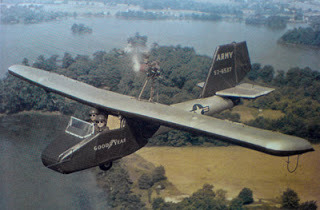 Top Speed: Umm, don't want to find outIf you're in the army and want to fly over enemy territory, what better way than in an inflatable plane, right? Developed in the 1950's and 60's, the idea was to have a lightweight, easy to transport plane used for observation. Unfortunately, it had a fatal crash during a test flight when the propeller chopped up one of the wings, and it deflated. The Inflatoplane makes my idea of a personal dirigible seem sane.
Top Speed: Umm, don't want to find outIf you're in the army and want to fly over enemy territory, what better way than in an inflatable plane, right? Developed in the 1950's and 60's, the idea was to have a lightweight, easy to transport plane used for observation. Unfortunately, it had a fatal crash during a test flight when the propeller chopped up one of the wings, and it deflated. The Inflatoplane makes my idea of a personal dirigible seem sane.
Finally, we have the Northrop M2-F2 Lifting Body :
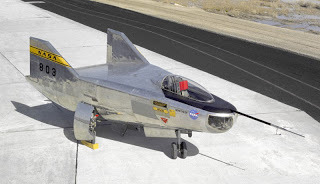 Top Speed: Probably classified...If it looks kind of familiar, it may be because you remember it from the opening of every episode of The Six Million Dollar Man. This is the ship Colonel Steve Austin crashed, which caused him to be "...a man barely alive." I've always thought this was one of the coolest looking spaceships, even if in reality it wasn't really a spaceship. The TV series actually used real-life footage of the M2-F2 and another Lifting Body ship, the HL-10.
Top Speed: Probably classified...If it looks kind of familiar, it may be because you remember it from the opening of every episode of The Six Million Dollar Man. This is the ship Colonel Steve Austin crashed, which caused him to be "...a man barely alive." I've always thought this was one of the coolest looking spaceships, even if in reality it wasn't really a spaceship. The TV series actually used real-life footage of the M2-F2 and another Lifting Body ship, the HL-10.
The cool thing about these aircraft is that they don't have wings. The whole body of the ship is essentially the wing, which was (and still is) a pretty radical idea. The problem was, aside from the cool looks, it could be very unstable. The M2-F2 was subject to something called "Pilot Induced Oscillation" and crashed in spectacular fashion. It was footage of this crash that was on the $6M Man open and actually inspired the novel Cyborg that the TV series was based on. Luckily the real-life pilot survived, although seriously injured.
In a "more things change, the more they stay the same" kind of way, this same Lifting Body concept is now being used by the Dream Chaser Space System, which is on the verge of being the next (and possibly only) alternative to Soyuz for getting astronauts to the International Space Station, now that NASA is out of the picture.
There's more in the Weird Garage, but this will do for now. So, who wants to go for a ride in the Inflatoplane?

 Top Speed: 70mph Land - 10 knots Sea
Top Speed: 70mph Land - 10 knots SeaFirst up is the Surface Orbiter . Made from a 1958 milk tanker (there are such things as milk tankers??) the Surface Orbiter is designed to circumnavigate the globe. Self sufficient and capable of traveling over land and sea, it has ventured over 33,000 miles on land and 3,000 miles at sea in the quest to travel around the world.
It took four years and 14,000 hours to build, and was able to travel through 28 countries and two continents before the around-the-world quest was cut short due to lack of funding. It kind of reminds me of the Landmaster from Damnation Alley .
Next up, from the "What Were They Thinking??" part of the Garage is the Goodyear Inflatoplane:
 Top Speed: Umm, don't want to find outIf you're in the army and want to fly over enemy territory, what better way than in an inflatable plane, right? Developed in the 1950's and 60's, the idea was to have a lightweight, easy to transport plane used for observation. Unfortunately, it had a fatal crash during a test flight when the propeller chopped up one of the wings, and it deflated. The Inflatoplane makes my idea of a personal dirigible seem sane.
Top Speed: Umm, don't want to find outIf you're in the army and want to fly over enemy territory, what better way than in an inflatable plane, right? Developed in the 1950's and 60's, the idea was to have a lightweight, easy to transport plane used for observation. Unfortunately, it had a fatal crash during a test flight when the propeller chopped up one of the wings, and it deflated. The Inflatoplane makes my idea of a personal dirigible seem sane.Finally, we have the Northrop M2-F2 Lifting Body :
 Top Speed: Probably classified...If it looks kind of familiar, it may be because you remember it from the opening of every episode of The Six Million Dollar Man. This is the ship Colonel Steve Austin crashed, which caused him to be "...a man barely alive." I've always thought this was one of the coolest looking spaceships, even if in reality it wasn't really a spaceship. The TV series actually used real-life footage of the M2-F2 and another Lifting Body ship, the HL-10.
Top Speed: Probably classified...If it looks kind of familiar, it may be because you remember it from the opening of every episode of The Six Million Dollar Man. This is the ship Colonel Steve Austin crashed, which caused him to be "...a man barely alive." I've always thought this was one of the coolest looking spaceships, even if in reality it wasn't really a spaceship. The TV series actually used real-life footage of the M2-F2 and another Lifting Body ship, the HL-10.The cool thing about these aircraft is that they don't have wings. The whole body of the ship is essentially the wing, which was (and still is) a pretty radical idea. The problem was, aside from the cool looks, it could be very unstable. The M2-F2 was subject to something called "Pilot Induced Oscillation" and crashed in spectacular fashion. It was footage of this crash that was on the $6M Man open and actually inspired the novel Cyborg that the TV series was based on. Luckily the real-life pilot survived, although seriously injured.
In a "more things change, the more they stay the same" kind of way, this same Lifting Body concept is now being used by the Dream Chaser Space System, which is on the verge of being the next (and possibly only) alternative to Soyuz for getting astronauts to the International Space Station, now that NASA is out of the picture.
There's more in the Weird Garage, but this will do for now. So, who wants to go for a ride in the Inflatoplane?
Published on May 04, 2012 16:56
April 29, 2012
Gold Rush and Hunger Games
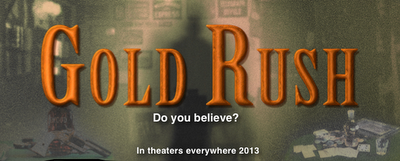 Hello Blogworld, this is Jon.
Hello Blogworld, this is Jon.Hopefully there are still some Mythik Readers out there ;) So here's the deal: April has slipped away in the blink of an eye, just like March did, because my schedule has been extremely busy. I did finish a screenplay for a paranormal thriller and have been doing multiple re-writes. Writing for the silver screen is a bit different than writing a novel, of course. The rewrites aren't just for plot or characterization, but also fall along the lines of "our special effects department needs more info to make the blank" or "we can't afford to do that" etc. But it is definitely fun.
The movie is called Gold Rush and is a high-tech paranormal thriller about a team of experts who investigate the Sunshine Mining Camp, a location with over 100 years of haunted history filled with mystery, murder and curses. It takes a headlong plunge into the depths of the nature of belief, reality and the powers of the human mind. It's in pre-production now, and shooting will begin in June. I'll be posting updates here, and soon it should have it's own blog. It's pretty exciting, because it will be using special cinematic techniques to produce a very cool "look" to emphasize the story and characters.
In other news, I've been very busy at the day job. Among a ton of projects (including one of my favorites, Breaking Bad Season 4) I just wrapped up encoding the HD video for the Ghost Rider: Spirit of Vengeance 3D and 2D Blu-ray discs. The directors Neveldine and Taylor (who also did the Crank series and Gamer) always come up with innovative filming techniques. The special commentary on the 2D version is really cool and shows just how they accomplished a lot of the stunts and effects.
My schedule is going to get crazy again for the upcoming Blu-ray release of The Hunger Games . I know, it's a pretty obscure little movie that nobody has heard of ;) I must admit, I am one of less than a dozen people on Earth who hasn't read the books, but I did really like the movie. Much better than the usual Hollywood Blockbuster Adaptation. Coming to the story blind, I thought they did a good job setting up the world and characters. I dug the whole retro-future look of it all. The train ride was cool: "That is mahogany!" So, there you have my 10-second review. The Blu-ray should have a lot of great stuff on it.
Finally, in between the movie stuff, I am determined to get the next Mythik Imagination out. I'm only almost a year behind schedule ;) Oh, and Land of Lor is coming along nicely. And by "nicely" I mean "mish-mash of Sword & Sorcery, High Fantasy and something-punk, with crazy minor characters coming out of the woodwork and creating chaos." Ah, the joys of the writing process.
And I pledge to be a better blogger...
Published on April 29, 2012 09:35
February 29, 2012
Screenplay
I blink my eyes and next thing I know, all of this extra long month of February has gone by. I have been typing furiously for most of the month on a movie script. February 29th is my deadline (at least for the first draft) and I am almost done. I've got 126 script pages done, and am working on rewriting the story.
So, I have regressed in my social media commitments, but made very good writing progress. I need to catch up with a lot of stuff, but will get back into good blogging form soon. Hopefully.
Well, I still have a few hours left until my writing deadline is officially here, so I better get back to work :)
So, I have regressed in my social media commitments, but made very good writing progress. I need to catch up with a lot of stuff, but will get back into good blogging form soon. Hopefully.
Well, I still have a few hours left until my writing deadline is officially here, so I better get back to work :)
Published on February 29, 2012 22:39
January 31, 2012
Action, Thriller, Comedy, Drama
I think, when people talk about genres, most people think of them in terms of what the story is about. Instead, I think a genre is really much more about who the audience is for a particular story.
I recently came across a fascinating analysis of spec script sales by genre from the Go Into The Story blog by Scott Myers. A "spec" script is when a screenwriter sells a script "on spec," which means they weren't hired to write a specific story; instead, they write whatever they think will be marketable and then hope to sell it to a producer. They are speculating, gambling their time and effort in hopes of a future sale. It's always interesting to see what kinds of stories Hollywood thinks will make them money. What I find particularly interesting, is to see the breakdown by the four major Hollywood genres: Action, Thriller, Comedy, and Drama.
Now, this kind of analysis is not an exact science, especially when you are dealing with the murky interior of a Hollywood crystal ball. Having said that, it is useful to get a generalized idea of what kind of stories are "hot," or at least were in 2011 (which, given the lead time of production, won't hit the theaters - if they ever do - until 2013 or 2014.)
Overall, there were 110 spec script sales in Hollywood in 2011. Quick side note: Think about that for a minute, all you aspiring screenwriters. Imagine all the thousands of scripts that studio readers probably had in their slush piles. Studio execs read hundreds of scripts a year. Their assistants and people whose job consists almost entirely of reading, read hundreds more. So the percentage of spec script purchases, verses the total number of scripts floating out there is pretty low. I'm not trying to be Debbie Downer here, I just think it's interesting.
Okay, let's break down some numbers. I have taken the liberty of combining some of Mr. Myers figures. I combined Action with Science Fiction, since it seems to be a rare Hollywood SF movie that is more cerebral than action oriented (although Moon by
Action - 42Thriller - 28Comedy - 19Drama - 14Other - 7The overall trend is unsurprising in that Action is king. Just look at the top all time box office numbers and count how many action movies are in the top 25. If you broaden the action brush to include science fiction and fantasy animation, then they are almost all action, with the three exceptions being high concept, larger than life Dramas.
In 2011, only 14 sales out of the countless thousands of spec scripts were Dramas. That doesn't bode well for your coming of age tale about the struggles of a farm boy set in the 1930s dust bowl. Better change the location to a desert planet and add a mysterious mentor, a space princess and an evil galactic empire. Or elves.
I'm kidding. Mostly. I think it's pretty funny that in the fiction book world, "genres" generally play second fiddle to "literary" fiction, while in Hollywood it's just the opposite. However, right now the top three spots in the Kindle Top 10 are Hunger Games, so go figure ;)
Hollywood's conventional wisdom has been that their biggest demographic is young males (although this very insightful post disagrees, and says women actually buy more tickets ) aged 13-24. What Hollywood thinks the young male demographic wants to see most is giant robots, lots of explosions and lots of lasers and/or gunfire. And elves and/or hobbits. And young wizards. So we can define the action genre as an audience of mostly teenage boys who like explosions. And sequels. I think that is going to all change. Probably sooner, rather than later, too.
Without going into some pretty boring statistics and research data, I think it is safe to say that what this boils down to is that you must know the audience you wish to reach and work back from that to tailor your genre to that specific audience. We live in rapidly changing times, and YouTube, eBooks and other yet - but no doubt soon - to be invented technologies are revolutionizing and revitalizing the industries of storytelling.
I'm not predicting that giant robotic explosions and sequels will go away, but I do think they will take a more creative form that dares to step away from more traditional Hollywood formulas and classifications. As truly "independent" (and by "independent" I mean really independent, not the "smaller studio with smaller big budget" type of independent) filmmakers and independent publishers/authors have more opportunities to showcase their stories to the world, we'll see new audiences enjoy genres that would have otherwise rarely been given the spotlight.
What are your favorite (new or old) genres? What kind of stories do you like?

I recently came across a fascinating analysis of spec script sales by genre from the Go Into The Story blog by Scott Myers. A "spec" script is when a screenwriter sells a script "on spec," which means they weren't hired to write a specific story; instead, they write whatever they think will be marketable and then hope to sell it to a producer. They are speculating, gambling their time and effort in hopes of a future sale. It's always interesting to see what kinds of stories Hollywood thinks will make them money. What I find particularly interesting, is to see the breakdown by the four major Hollywood genres: Action, Thriller, Comedy, and Drama.
Now, this kind of analysis is not an exact science, especially when you are dealing with the murky interior of a Hollywood crystal ball. Having said that, it is useful to get a generalized idea of what kind of stories are "hot," or at least were in 2011 (which, given the lead time of production, won't hit the theaters - if they ever do - until 2013 or 2014.)
Overall, there were 110 spec script sales in Hollywood in 2011. Quick side note: Think about that for a minute, all you aspiring screenwriters. Imagine all the thousands of scripts that studio readers probably had in their slush piles. Studio execs read hundreds of scripts a year. Their assistants and people whose job consists almost entirely of reading, read hundreds more. So the percentage of spec script purchases, verses the total number of scripts floating out there is pretty low. I'm not trying to be Debbie Downer here, I just think it's interesting.
Okay, let's break down some numbers. I have taken the liberty of combining some of Mr. Myers figures. I combined Action with Science Fiction, since it seems to be a rare Hollywood SF movie that is more cerebral than action oriented (although Moon by
Action - 42Thriller - 28Comedy - 19Drama - 14Other - 7The overall trend is unsurprising in that Action is king. Just look at the top all time box office numbers and count how many action movies are in the top 25. If you broaden the action brush to include science fiction and fantasy animation, then they are almost all action, with the three exceptions being high concept, larger than life Dramas.
In 2011, only 14 sales out of the countless thousands of spec scripts were Dramas. That doesn't bode well for your coming of age tale about the struggles of a farm boy set in the 1930s dust bowl. Better change the location to a desert planet and add a mysterious mentor, a space princess and an evil galactic empire. Or elves.
I'm kidding. Mostly. I think it's pretty funny that in the fiction book world, "genres" generally play second fiddle to "literary" fiction, while in Hollywood it's just the opposite. However, right now the top three spots in the Kindle Top 10 are Hunger Games, so go figure ;)
Hollywood's conventional wisdom has been that their biggest demographic is young males (although this very insightful post disagrees, and says women actually buy more tickets ) aged 13-24. What Hollywood thinks the young male demographic wants to see most is giant robots, lots of explosions and lots of lasers and/or gunfire. And elves and/or hobbits. And young wizards. So we can define the action genre as an audience of mostly teenage boys who like explosions. And sequels. I think that is going to all change. Probably sooner, rather than later, too.
Without going into some pretty boring statistics and research data, I think it is safe to say that what this boils down to is that you must know the audience you wish to reach and work back from that to tailor your genre to that specific audience. We live in rapidly changing times, and YouTube, eBooks and other yet - but no doubt soon - to be invented technologies are revolutionizing and revitalizing the industries of storytelling.
I'm not predicting that giant robotic explosions and sequels will go away, but I do think they will take a more creative form that dares to step away from more traditional Hollywood formulas and classifications. As truly "independent" (and by "independent" I mean really independent, not the "smaller studio with smaller big budget" type of independent) filmmakers and independent publishers/authors have more opportunities to showcase their stories to the world, we'll see new audiences enjoy genres that would have otherwise rarely been given the spotlight.
What are your favorite (new or old) genres? What kind of stories do you like?
Published on January 31, 2012 21:37
January 26, 2012
Weird Thursday - Weird Vehicles Part 1
Today's weirdness is a day late, but is hopefully worth the wait. We've got a garage full of odd sci-fi conveyances that are (or have been) real, believe it or not. It ended up being rather crowded in our Weird Garage, so this is Weird Vehicles Part 1.
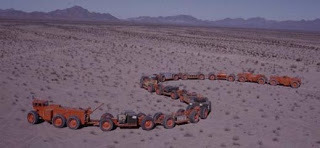 Top Speed: 20 mphFirst up is the
LeTourneau Overland MkII Land Train
. It is like the Antarctic Snow Cruiser on steroids. Perfect for hauling much needed supplies across the Martian tundra (or across earthly deserts,) the Overland MkII was as long as two football fields. It had 54 electrically powered wheels and could carry 150 tons of cargo. Each wheel was over 11 feet tall. The idea was that it would be used by the Army to deliver goods to inhospitable and remote locales, but by the time it was ready for action in 1962, it was rendered obsolete by newly developed aircraft technologies. Sadly, most of the Land Train has been sold for scrap, although you can still see the restored lead car at the Yuma Proving Grounds Heritage Center.
Top Speed: 20 mphFirst up is the
LeTourneau Overland MkII Land Train
. It is like the Antarctic Snow Cruiser on steroids. Perfect for hauling much needed supplies across the Martian tundra (or across earthly deserts,) the Overland MkII was as long as two football fields. It had 54 electrically powered wheels and could carry 150 tons of cargo. Each wheel was over 11 feet tall. The idea was that it would be used by the Army to deliver goods to inhospitable and remote locales, but by the time it was ready for action in 1962, it was rendered obsolete by newly developed aircraft technologies. Sadly, most of the Land Train has been sold for scrap, although you can still see the restored lead car at the Yuma Proving Grounds Heritage Center.
 Top Speed: Estimated 12 mphThe internet is great for finding all the brilliant things you may have thought you alone dreamed up, but have already been invented by somebody else. As a certain unnamed someone can cringingly attest to, the idea of a personal blimp has long been a dream of mine. Imagine skimming a few dozens of feet off the ground in majestic silence as you soar over some impossibly beautiful, normally inaccessible, scenery. I still haven't completely given up on my idea of a small one-person helium dirigible, but the
Personal Blimp
is the closest thing I've found in the meantime. The airship Alberto gets its lift from hot air rather than helium, and is umm, somewhat more expensive than I'd like my blimp to be, but hey that's a small price to pay for one cool steampunk ride. Oh, the internet also showed me I was into steampunk before I even knew what it was. Thanks a lot, internet.
Top Speed: Estimated 12 mphThe internet is great for finding all the brilliant things you may have thought you alone dreamed up, but have already been invented by somebody else. As a certain unnamed someone can cringingly attest to, the idea of a personal blimp has long been a dream of mine. Imagine skimming a few dozens of feet off the ground in majestic silence as you soar over some impossibly beautiful, normally inaccessible, scenery. I still haven't completely given up on my idea of a small one-person helium dirigible, but the
Personal Blimp
is the closest thing I've found in the meantime. The airship Alberto gets its lift from hot air rather than helium, and is umm, somewhat more expensive than I'd like my blimp to be, but hey that's a small price to pay for one cool steampunk ride. Oh, the internet also showed me I was into steampunk before I even knew what it was. Thanks a lot, internet.
We're going to round out this edition of Weird Vehicles with the Sakakibara Kikai Landwalker . It may look like a fitting opponent for Iron Man, or a way for the Empire to finally put down those pesky rebels, but you can actually take the Landwalker for a spin today. The price? only 36,000,000 yen. Let see, that comes to about $461,834.68. Shipping is probably extra. Oh, it also is armed with a canon that shoots foam balls. Score one for the Empire.
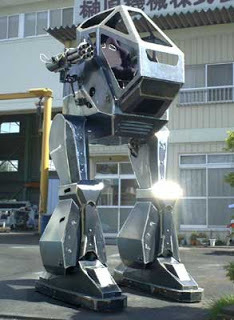 Top Speed: Looks like about 1/4 mph.So, have you seen any weird vehicles in your travels?
Top Speed: Looks like about 1/4 mph.So, have you seen any weird vehicles in your travels?

 Top Speed: 20 mphFirst up is the
LeTourneau Overland MkII Land Train
. It is like the Antarctic Snow Cruiser on steroids. Perfect for hauling much needed supplies across the Martian tundra (or across earthly deserts,) the Overland MkII was as long as two football fields. It had 54 electrically powered wheels and could carry 150 tons of cargo. Each wheel was over 11 feet tall. The idea was that it would be used by the Army to deliver goods to inhospitable and remote locales, but by the time it was ready for action in 1962, it was rendered obsolete by newly developed aircraft technologies. Sadly, most of the Land Train has been sold for scrap, although you can still see the restored lead car at the Yuma Proving Grounds Heritage Center.
Top Speed: 20 mphFirst up is the
LeTourneau Overland MkII Land Train
. It is like the Antarctic Snow Cruiser on steroids. Perfect for hauling much needed supplies across the Martian tundra (or across earthly deserts,) the Overland MkII was as long as two football fields. It had 54 electrically powered wheels and could carry 150 tons of cargo. Each wheel was over 11 feet tall. The idea was that it would be used by the Army to deliver goods to inhospitable and remote locales, but by the time it was ready for action in 1962, it was rendered obsolete by newly developed aircraft technologies. Sadly, most of the Land Train has been sold for scrap, although you can still see the restored lead car at the Yuma Proving Grounds Heritage Center. Top Speed: Estimated 12 mphThe internet is great for finding all the brilliant things you may have thought you alone dreamed up, but have already been invented by somebody else. As a certain unnamed someone can cringingly attest to, the idea of a personal blimp has long been a dream of mine. Imagine skimming a few dozens of feet off the ground in majestic silence as you soar over some impossibly beautiful, normally inaccessible, scenery. I still haven't completely given up on my idea of a small one-person helium dirigible, but the
Personal Blimp
is the closest thing I've found in the meantime. The airship Alberto gets its lift from hot air rather than helium, and is umm, somewhat more expensive than I'd like my blimp to be, but hey that's a small price to pay for one cool steampunk ride. Oh, the internet also showed me I was into steampunk before I even knew what it was. Thanks a lot, internet.
Top Speed: Estimated 12 mphThe internet is great for finding all the brilliant things you may have thought you alone dreamed up, but have already been invented by somebody else. As a certain unnamed someone can cringingly attest to, the idea of a personal blimp has long been a dream of mine. Imagine skimming a few dozens of feet off the ground in majestic silence as you soar over some impossibly beautiful, normally inaccessible, scenery. I still haven't completely given up on my idea of a small one-person helium dirigible, but the
Personal Blimp
is the closest thing I've found in the meantime. The airship Alberto gets its lift from hot air rather than helium, and is umm, somewhat more expensive than I'd like my blimp to be, but hey that's a small price to pay for one cool steampunk ride. Oh, the internet also showed me I was into steampunk before I even knew what it was. Thanks a lot, internet.We're going to round out this edition of Weird Vehicles with the Sakakibara Kikai Landwalker . It may look like a fitting opponent for Iron Man, or a way for the Empire to finally put down those pesky rebels, but you can actually take the Landwalker for a spin today. The price? only 36,000,000 yen. Let see, that comes to about $461,834.68. Shipping is probably extra. Oh, it also is armed with a canon that shoots foam balls. Score one for the Empire.
 Top Speed: Looks like about 1/4 mph.So, have you seen any weird vehicles in your travels?
Top Speed: Looks like about 1/4 mph.So, have you seen any weird vehicles in your travels?
Published on January 26, 2012 06:30
January 21, 2012
Fantasy Map Tutorial
There's a lot of talk these days about "World Building," which helps create a realistic and interesting story setting. But after you have carefully crafted your world of wonder with believable geographic and geopolitical details, you probably want a nice picture of it, right?
I'm going to show you how to make a cool looking fantasy map.
What you will need:
- a graphics editing program (I used Photoshop.) There is also a free program called GIMP.
- a public domain image of an old map. Some good sources for public domain images are: Public Domain Sherpa and NOAA's Office of Coast Survey Historical Map & Chart Collection. The NOAA site is a gold mine. It takes some searching, but you can even find maps of old west towns, forts, and battles!
What we are going to do:
We are going to take an existing public domain map and modify it to look like the imaginary world we have in our head.
First, here is the public domain map we'll use for this tutorial:
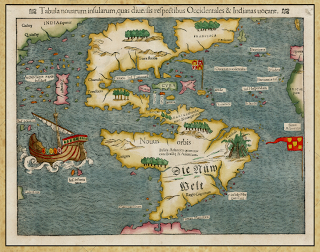 Public Domain MapI picked this one because it was pretty old, looks hand drawn, and has a cool textures and colors.
Public Domain MapI picked this one because it was pretty old, looks hand drawn, and has a cool textures and colors.
Next, we'll make an outline of our world:
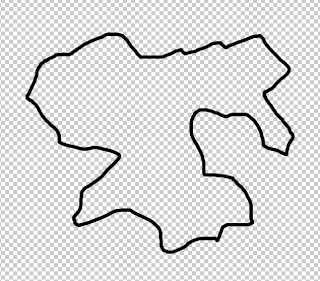 Outline GuideI just scribbled this out quickly. It won't be the exact final shape, but we'll use it as a guide.
Outline GuideI just scribbled this out quickly. It won't be the exact final shape, but we'll use it as a guide.
Now we'll overlay the guide over the map and see if we can move and/or resize things a bit to match any of the coastlines with the outline guide:
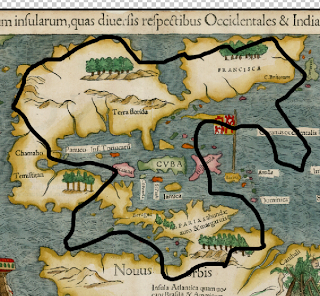 Add captionThe northwest coast matches up pretty well, so I'll leave that there. We're going to duplicate the map layer, and then copy a selection of the map so we can modify it to match the guide:
Add captionThe northwest coast matches up pretty well, so I'll leave that there. We're going to duplicate the map layer, and then copy a selection of the map so we can modify it to match the guide:
 Select the Marquee Tool
Select the Marquee Tool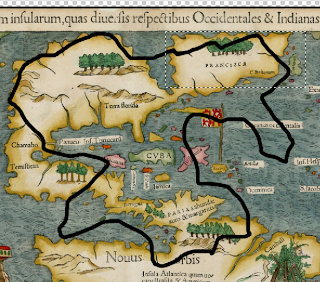 Select the part of the map we want to modify.
Select the part of the map we want to modify.
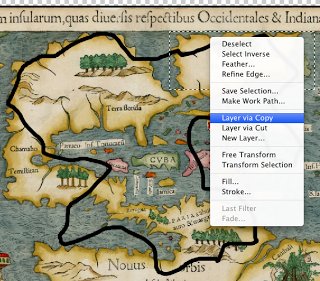 Right (or Control) click and select "Layer via Copy."
Right (or Control) click and select "Layer via Copy."
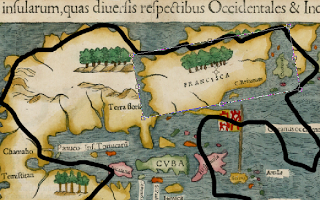 Move the new layer into position and rotate.Next, we'll start erasing the background:
Move the new layer into position and rotate.Next, we'll start erasing the background:
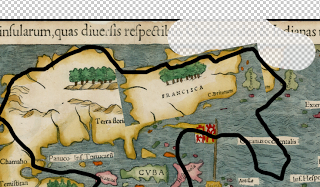 Use the erase tool with a big brush.
Use the erase tool with a big brush.
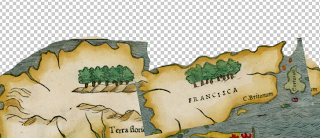 Then use a much finer brush to erase the new layer along the coast.
Then use a much finer brush to erase the new layer along the coast.
 Then just carefully continue erasing.
Then just carefully continue erasing.
 Merge the new layer with the background, and keep erasing.Now we'll use the same "Layer via Copy" technique to modify the west coast:
Merge the new layer with the background, and keep erasing.Now we'll use the same "Layer via Copy" technique to modify the west coast:
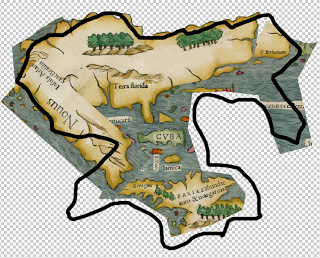
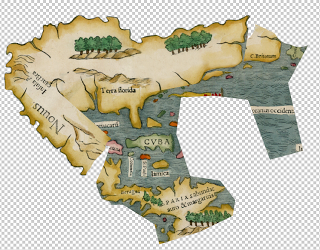 Then erase, merge, and keep erasing.
Then erase, merge, and keep erasing.
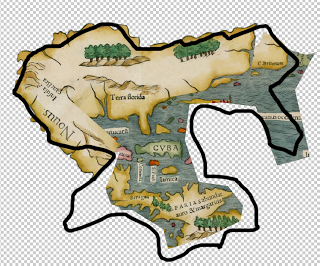 Our world is starting to take shape!Then we want to use the Clone Tool to get rid of the words and also fill in the interior:
Our world is starting to take shape!Then we want to use the Clone Tool to get rid of the words and also fill in the interior:
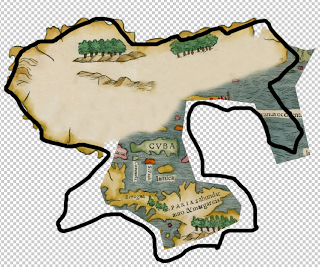
Normally, we'd just rinse and repeat until we'd filled in all of our coast lines. (Remember to Select Layer via Copy from the original map layer to get new coast line material.) But for now, I'm just going to skip ahead to the background step:
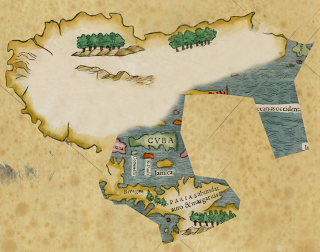 I found the background from the NOAA web site above.
I found the background from the NOAA web site above.
 I add a semi transparent color layer between the map and the background.
I add a semi transparent color layer between the map and the background.
Play around with layer composite settings and filters and effects. So here's what we have created so far.I've used this technique for my own work in progress, the fantastical Land of Lor:
So here's what we have created so far.I've used this technique for my own work in progress, the fantastical Land of Lor:
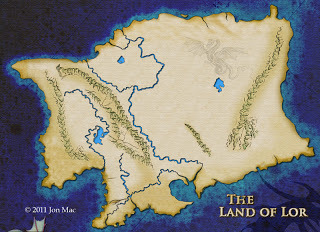
It is still very much a work in progress and needs to be broken up a bit (looks too rectangular right now,) but you can see how this technique can be used to create just about any map shape you want. Then it's just a matter of tweaking it and adding rivers, lakes, mountains etc. You can add sea monsters, "Here Be Dragons," mermaids, sailing ships etc. Karen's Whimsy has a lot of good public domain images for that kind of stuff.
Now what are you waiting for? Go create some worlds!
I hope you enjoyed this tutorial. Please find me on line to say hi, talk about SF & Fantasy, or whatever :)
Jon Mac on Twitter, Facebook, Google+, Goodreads
Thanks for reading!
Jon
I'm going to show you how to make a cool looking fantasy map.
What you will need:
- a graphics editing program (I used Photoshop.) There is also a free program called GIMP.
- a public domain image of an old map. Some good sources for public domain images are: Public Domain Sherpa and NOAA's Office of Coast Survey Historical Map & Chart Collection. The NOAA site is a gold mine. It takes some searching, but you can even find maps of old west towns, forts, and battles!
What we are going to do:
We are going to take an existing public domain map and modify it to look like the imaginary world we have in our head.
First, here is the public domain map we'll use for this tutorial:
 Public Domain MapI picked this one because it was pretty old, looks hand drawn, and has a cool textures and colors.
Public Domain MapI picked this one because it was pretty old, looks hand drawn, and has a cool textures and colors.Next, we'll make an outline of our world:
 Outline GuideI just scribbled this out quickly. It won't be the exact final shape, but we'll use it as a guide.
Outline GuideI just scribbled this out quickly. It won't be the exact final shape, but we'll use it as a guide.Now we'll overlay the guide over the map and see if we can move and/or resize things a bit to match any of the coastlines with the outline guide:
 Add captionThe northwest coast matches up pretty well, so I'll leave that there. We're going to duplicate the map layer, and then copy a selection of the map so we can modify it to match the guide:
Add captionThe northwest coast matches up pretty well, so I'll leave that there. We're going to duplicate the map layer, and then copy a selection of the map so we can modify it to match the guide: Select the Marquee Tool
Select the Marquee Tool Select the part of the map we want to modify.
Select the part of the map we want to modify. Right (or Control) click and select "Layer via Copy."
Right (or Control) click and select "Layer via Copy."
 Move the new layer into position and rotate.Next, we'll start erasing the background:
Move the new layer into position and rotate.Next, we'll start erasing the background: Use the erase tool with a big brush.
Use the erase tool with a big brush.
 Then use a much finer brush to erase the new layer along the coast.
Then use a much finer brush to erase the new layer along the coast.
 Then just carefully continue erasing.
Then just carefully continue erasing.
 Merge the new layer with the background, and keep erasing.Now we'll use the same "Layer via Copy" technique to modify the west coast:
Merge the new layer with the background, and keep erasing.Now we'll use the same "Layer via Copy" technique to modify the west coast:
 Then erase, merge, and keep erasing.
Then erase, merge, and keep erasing.
 Our world is starting to take shape!Then we want to use the Clone Tool to get rid of the words and also fill in the interior:
Our world is starting to take shape!Then we want to use the Clone Tool to get rid of the words and also fill in the interior:
Normally, we'd just rinse and repeat until we'd filled in all of our coast lines. (Remember to Select Layer via Copy from the original map layer to get new coast line material.) But for now, I'm just going to skip ahead to the background step:
 I found the background from the NOAA web site above.
I found the background from the NOAA web site above.
 I add a semi transparent color layer between the map and the background.
I add a semi transparent color layer between the map and the background.Play around with layer composite settings and filters and effects.
 So here's what we have created so far.I've used this technique for my own work in progress, the fantastical Land of Lor:
So here's what we have created so far.I've used this technique for my own work in progress, the fantastical Land of Lor:
It is still very much a work in progress and needs to be broken up a bit (looks too rectangular right now,) but you can see how this technique can be used to create just about any map shape you want. Then it's just a matter of tweaking it and adding rivers, lakes, mountains etc. You can add sea monsters, "Here Be Dragons," mermaids, sailing ships etc. Karen's Whimsy has a lot of good public domain images for that kind of stuff.
Now what are you waiting for? Go create some worlds!
I hope you enjoyed this tutorial. Please find me on line to say hi, talk about SF & Fantasy, or whatever :)
Jon Mac on Twitter, Facebook, Google+, Goodreads
Thanks for reading!
Jon
Published on January 21, 2012 13:14
January 18, 2012
Weird Wednesday - Phaistos Disc and Rongorongo
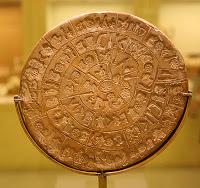 Phaistos Disc - Side A
Phaistos Disc - Side A(click to supersize)For some reason, I am fascinated by mysterious, undeciphered writing (check out Weird Wednesday - The Voynich Manuscript.) Today, we have not one, but two good mysteries from the Mythik Story Idea List And Weird Things File :)
The Phaistos Disc is, oddly enough, an approximately 3600 year old disc-shaped clay artifact discovered in Crete in 1908. Although the dating is imprecise, and some archeologists do think it is a hoax, it is generally accepted by the scientific community as the real deal.
It has symbols or "signs" in a spiral pattern on both sides. There are 45 unique signs that make up its "alphabet," and there are a total of 241 "tokens" made up of the signs. Many of the signs seem to represent people, faces, and objects such as weapons and tools. The signs have been compared to the symbols in Linear A and Anatolian and even Egyptian Hieroglyphics. There is even a theory that it may be the result of the world's first printing press. But so far, nobody has been able to come up with a conclusive translation.
 Phaistos Disc - Side B
Phaistos Disc - Side BWhat do you think? Is it a recipe? A board game? The headpiece to the Staff of Ra?
Or perhaps an Anti-Gravity Pyramid Builder Instruction Manual?That doesn't mean everybody and their dog hasn't attempted to decipher it, though. So go ahead, get out your handy Indiana Jones Ancient Language Decoder Book and give it a shot. Let me know what you come up with :)
If you get stuck with the Phaistos Disc, you can always try your hand at decoding Rongorongo. This mysterious script comes from the equally mysterious Easter Island. It first became known in the late 19th century, but by then it seems anybody who knew how to read it had died off (or been killed.)
 RongorongoTo make matters worse, the pieces of wood containing the writing were often used as firewood or used to wind fishing lines. If you want to take a crack at reading it, it is theorized that you read from left to right, beginning at the bottom, then rotate it 180 degrees and continue the next line.
RongorongoTo make matters worse, the pieces of wood containing the writing were often used as firewood or used to wind fishing lines. If you want to take a crack at reading it, it is theorized that you read from left to right, beginning at the bottom, then rotate it 180 degrees and continue the next line.Some of the characters appear to be people and animals, and the writing was engraved with a shark's tooth. Nobody knows for sure how to read it, of course, but one surviving fragment is believed to be a lunar calendar.
What do you think?
Published on January 18, 2012 23:00
January 14, 2012
Jon Mac On The Radio
Today I was on the Leo Laporte show, a nationally syndicated radio program about all things tech and geek ;) I've always loved listening to Leo and it was great fun to speak with him.
 We talked about using older, manual focus lenses with new DSLR cameras. What does that have to do with writing, you ask? Heh, well I like to think of this blog as being about stories as much as writing, and A) storytelling is important in photographs and movies, and B) Using older lenses that are high quality and 1/10th the price of new ones is definitely in the Indy Author Spirit, and C) I'll be adapting some of the Mythik stories into movies using this technique ;)
We talked about using older, manual focus lenses with new DSLR cameras. What does that have to do with writing, you ask? Heh, well I like to think of this blog as being about stories as much as writing, and A) storytelling is important in photographs and movies, and B) Using older lenses that are high quality and 1/10th the price of new ones is definitely in the Indy Author Spirit, and C) I'll be adapting some of the Mythik stories into movies using this technique ;)
Here's the snippet from the radio:
A lot of people are taking advantage of this combination of new and old tech in a lot of creative ways. It's definitely a fun pairing of retro and future :) Whether you're a reader, watcher, writer, or filmmaker, the "democratization" of creative technology only makes the world a better place.
It occurs to me that I do seem to talk a lot about living in the future. It's not just because I like science fiction stories. It is because the future has turned out to be pretty cool, and I like being in the world that would have seemed like science fiction to somebody living 20 years ago. I used to work on the fringes of the tech industry, and for years the biggest buzzword was "convergence." The idea was that soon all kinds of different technologies would merge together to make something completely new and unexpected. One example the experts often liked to use was that your refrigerator would connect to the internet and would automatically buy milk when you ran out. Ha, my fridge is still embarrassingly dumb, but my phone is smart. And Kindles, Nooks, iPads, smartphones and YouTube are blurring the lines between readers and writers and audiences and film makers. I think the long awaited convergence has converged, and we are already to the point where anybody can really do anything if they put enough thought, time and hard work into it.
So, Mythikal People, have you tried this out? Or do you have any other "out of the box" techniques you've tried? It doesn't need to be photo or movie related - it could be how you write a different way or interact differently or even the way you encounter stories (however they may be presented) in a new way.
What do you think?

 We talked about using older, manual focus lenses with new DSLR cameras. What does that have to do with writing, you ask? Heh, well I like to think of this blog as being about stories as much as writing, and A) storytelling is important in photographs and movies, and B) Using older lenses that are high quality and 1/10th the price of new ones is definitely in the Indy Author Spirit, and C) I'll be adapting some of the Mythik stories into movies using this technique ;)
We talked about using older, manual focus lenses with new DSLR cameras. What does that have to do with writing, you ask? Heh, well I like to think of this blog as being about stories as much as writing, and A) storytelling is important in photographs and movies, and B) Using older lenses that are high quality and 1/10th the price of new ones is definitely in the Indy Author Spirit, and C) I'll be adapting some of the Mythik stories into movies using this technique ;)Here's the snippet from the radio:
A lot of people are taking advantage of this combination of new and old tech in a lot of creative ways. It's definitely a fun pairing of retro and future :) Whether you're a reader, watcher, writer, or filmmaker, the "democratization" of creative technology only makes the world a better place.
It occurs to me that I do seem to talk a lot about living in the future. It's not just because I like science fiction stories. It is because the future has turned out to be pretty cool, and I like being in the world that would have seemed like science fiction to somebody living 20 years ago. I used to work on the fringes of the tech industry, and for years the biggest buzzword was "convergence." The idea was that soon all kinds of different technologies would merge together to make something completely new and unexpected. One example the experts often liked to use was that your refrigerator would connect to the internet and would automatically buy milk when you ran out. Ha, my fridge is still embarrassingly dumb, but my phone is smart. And Kindles, Nooks, iPads, smartphones and YouTube are blurring the lines between readers and writers and audiences and film makers. I think the long awaited convergence has converged, and we are already to the point where anybody can really do anything if they put enough thought, time and hard work into it.
So, Mythikal People, have you tried this out? Or do you have any other "out of the box" techniques you've tried? It doesn't need to be photo or movie related - it could be how you write a different way or interact differently or even the way you encounter stories (however they may be presented) in a new way.
What do you think?
Published on January 14, 2012 23:08
January 12, 2012
The Moon
As you can see from the incredibly creative title of this post, today we'll be talking about the moon. Not just any moon, but earth's moon. We love our moon so much, we didn't even bother to give it a real name and just call it "The Moon." It's kind of like naming your dog, "Dog." But whatever, I guess it gets the job done.
If you've read this far, you're now probably expecting some amazing little known science facts about our nearest heavenly neighbor, or maybe some comical old superstitions or moon hoaxes. Nope! Instead, I'm going to make you look at a picture. (Click the images for full size)
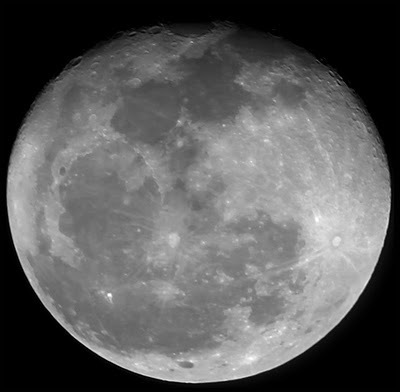 The Moon - Taken with Canon T3i + Vivitar Series 1 70-210mm f3.5
The Moon - Taken with Canon T3i + Vivitar Series 1 70-210mm f3.5
Notes: 210mm and 2X extender, plus 3X "lossless" center crop, f22, ISO 1600
Shot as 1080p video @ 30fps - image is about 100 stacked framesI wanted to test out my camera and lens and see how close I could come to duplicating an amazing picture by NASA of the Moon and the International Space Station. Yes, I do realize that my picture happens to be missing the amazing part, which is the ISS. But other than that, I was pretty happy with how it turned out. Here is a comparison: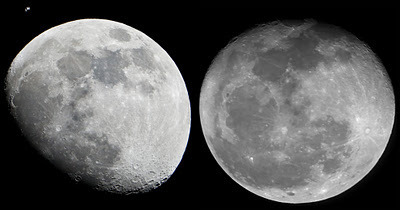 NASA on the left ---- Mythik on the rightOooh, darned your budget, NASA! My pic pales in comparison. But... It was my first try, and NASA took their pic when the Moon was in a different phase, which makes better shadows for much better details. My Moon was nearly full, which makes it look a lot more flat. (Is it just me or does that last sentence seem a bit odd?)
NASA on the left ---- Mythik on the rightOooh, darned your budget, NASA! My pic pales in comparison. But... It was my first try, and NASA took their pic when the Moon was in a different phase, which makes better shadows for much better details. My Moon was nearly full, which makes it look a lot more flat. (Is it just me or does that last sentence seem a bit odd?)
Now, the whole point of this isn't to show off the fact that I can aim a camera at a giant celestial body in the sky and snap a pic. Instead, the point is to show you what you can do, if you are interested.
I used a Canon T3i and a 30+ year old lens I bought from Goodwill for about 50 bucks and a $10 adaptor to make the old lens fit the camera. One cool thing about the T3i is a feature that can zoom the image when you are shooting HD 1080p video. Through some kind of magi-tech process, it does this allegedly without any loss of quality at 3X. I also used a 2X extender that came with the lens. So the total focal length ended up being 210mm X 2 X 3 = 1260mm! That's fairly close to the NASA photog's 600mm lens plus a 2X extender. Ha, I'm pretty sure their 600mm lens cost more than 50 bucks, though. Ok, before I get too smirky, here is a frame from the video I shot: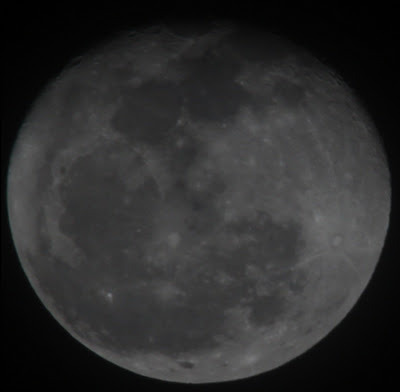 What?? Frame from 1080p video before processing.What?? Here's the scoop: There were whispy clouds that night, and the seeing wasn't very good. Seeing is when the atmosphere "boils" and causes things in the sky to look blurry. But it changes from moment to moment, so one second it might be clear, then the next second it is more blurry. So I exported the video to a sequence of 150 frames and processed them with a program called Keith's Image Stacker. This program is awesome and free! It allows you to cull out the blurry frames, and it "stacks" the good frames, which equalizes the brightness and lowers the noise and enhances the details and a ton of other cool things. Then you can sharpen the detail and voila:
What?? Frame from 1080p video before processing.What?? Here's the scoop: There were whispy clouds that night, and the seeing wasn't very good. Seeing is when the atmosphere "boils" and causes things in the sky to look blurry. But it changes from moment to moment, so one second it might be clear, then the next second it is more blurry. So I exported the video to a sequence of 150 frames and processed them with a program called Keith's Image Stacker. This program is awesome and free! It allows you to cull out the blurry frames, and it "stacks" the good frames, which equalizes the brightness and lowers the noise and enhances the details and a ton of other cool things. Then you can sharpen the detail and voila:

So if you like photography or astronomy or both, give it a try. All you need is a video capable DSLR, an old lens (or a new one,) a tripod and some free software. Here's my setup: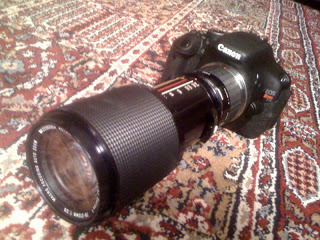 T3i + Vivitar Series 1 70-210mm f3.5 circa 1979Also check out M Pax at Wistful Nebulae who works at a real observatory in the summers and takes cool astro photos. Thanks for the inspiration M Pax!
T3i + Vivitar Series 1 70-210mm f3.5 circa 1979Also check out M Pax at Wistful Nebulae who works at a real observatory in the summers and takes cool astro photos. Thanks for the inspiration M Pax!
So, who here likes looking up at night?

If you've read this far, you're now probably expecting some amazing little known science facts about our nearest heavenly neighbor, or maybe some comical old superstitions or moon hoaxes. Nope! Instead, I'm going to make you look at a picture. (Click the images for full size)
 The Moon - Taken with Canon T3i + Vivitar Series 1 70-210mm f3.5
The Moon - Taken with Canon T3i + Vivitar Series 1 70-210mm f3.5Notes: 210mm and 2X extender, plus 3X "lossless" center crop, f22, ISO 1600
Shot as 1080p video @ 30fps - image is about 100 stacked framesI wanted to test out my camera and lens and see how close I could come to duplicating an amazing picture by NASA of the Moon and the International Space Station. Yes, I do realize that my picture happens to be missing the amazing part, which is the ISS. But other than that, I was pretty happy with how it turned out. Here is a comparison:
 NASA on the left ---- Mythik on the rightOooh, darned your budget, NASA! My pic pales in comparison. But... It was my first try, and NASA took their pic when the Moon was in a different phase, which makes better shadows for much better details. My Moon was nearly full, which makes it look a lot more flat. (Is it just me or does that last sentence seem a bit odd?)
NASA on the left ---- Mythik on the rightOooh, darned your budget, NASA! My pic pales in comparison. But... It was my first try, and NASA took their pic when the Moon was in a different phase, which makes better shadows for much better details. My Moon was nearly full, which makes it look a lot more flat. (Is it just me or does that last sentence seem a bit odd?)Now, the whole point of this isn't to show off the fact that I can aim a camera at a giant celestial body in the sky and snap a pic. Instead, the point is to show you what you can do, if you are interested.
I used a Canon T3i and a 30+ year old lens I bought from Goodwill for about 50 bucks and a $10 adaptor to make the old lens fit the camera. One cool thing about the T3i is a feature that can zoom the image when you are shooting HD 1080p video. Through some kind of magi-tech process, it does this allegedly without any loss of quality at 3X. I also used a 2X extender that came with the lens. So the total focal length ended up being 210mm X 2 X 3 = 1260mm! That's fairly close to the NASA photog's 600mm lens plus a 2X extender. Ha, I'm pretty sure their 600mm lens cost more than 50 bucks, though. Ok, before I get too smirky, here is a frame from the video I shot:
 What?? Frame from 1080p video before processing.What?? Here's the scoop: There were whispy clouds that night, and the seeing wasn't very good. Seeing is when the atmosphere "boils" and causes things in the sky to look blurry. But it changes from moment to moment, so one second it might be clear, then the next second it is more blurry. So I exported the video to a sequence of 150 frames and processed them with a program called Keith's Image Stacker. This program is awesome and free! It allows you to cull out the blurry frames, and it "stacks" the good frames, which equalizes the brightness and lowers the noise and enhances the details and a ton of other cool things. Then you can sharpen the detail and voila:
What?? Frame from 1080p video before processing.What?? Here's the scoop: There were whispy clouds that night, and the seeing wasn't very good. Seeing is when the atmosphere "boils" and causes things in the sky to look blurry. But it changes from moment to moment, so one second it might be clear, then the next second it is more blurry. So I exported the video to a sequence of 150 frames and processed them with a program called Keith's Image Stacker. This program is awesome and free! It allows you to cull out the blurry frames, and it "stacks" the good frames, which equalizes the brightness and lowers the noise and enhances the details and a ton of other cool things. Then you can sharpen the detail and voila:

So if you like photography or astronomy or both, give it a try. All you need is a video capable DSLR, an old lens (or a new one,) a tripod and some free software. Here's my setup:
 T3i + Vivitar Series 1 70-210mm f3.5 circa 1979Also check out M Pax at Wistful Nebulae who works at a real observatory in the summers and takes cool astro photos. Thanks for the inspiration M Pax!
T3i + Vivitar Series 1 70-210mm f3.5 circa 1979Also check out M Pax at Wistful Nebulae who works at a real observatory in the summers and takes cool astro photos. Thanks for the inspiration M Pax!So, who here likes looking up at night?
Published on January 12, 2012 16:47
January 10, 2012
Storytelling Is Time Travel
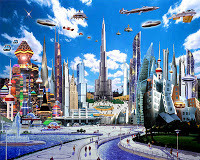 This is why there is so much construction
This is why there is so much constructionon the freeway of my daily commute.I'm the last person who would tell somebody how to write stories. But I was (sort of) asked. So here goes:
We're already 10/365ths (or 0.027397260 for you math whizzes) into the new year. So most of the yearly future predictions have already been predicted (December is that magical portal in-between the "Top-[insert number here]" lists of what has already happened and the "Top-[insert number here]" of what might happen - the internet loves lists even more than usual at this time of year.) How does this possibly relate to writing stories, you ask?
My thought is that all storytelling is essentially about time travel. It doesn't matter if it is a literary classic from Sophocles or Shakespeare or Hemingway or genre tales from Tolkien or Stephen King or the latest important "literature" you must have on your new Kindle or Nook. The story is all about one question: What happens next?
No matter what style is used to present the story, the most important thing is the emotional progression the reader goes through on their journey through time as they follow along. It's "A real page turner," right? Like the fine print in an investment sales pitch, "past performance is not an indicator of future returns." So we have that mystery of what the future of the story will hold, despite (or maybe because of) our expectations from what we have read so far.
Hmm, I won't use any more terms like "emotional progression" (for that, you need to listen to a real writing expert,) so instead, I'll use what I think is the best example of good storytelling: it's called "real life." Despite a prevailing healthy dose of boring-routine-rat-race angst, we really don't know what will happen in the future. (See Flying Cars, Jetpacks, And Video Phones.) Tomorrow, something unexpected can happen, ranging from the bad ("Gee, I wish I had looked both ways and seen that bus before I stepped into the street,") to the good ("Wow, I won the lottery!")
Of course, there's always the possibility of a Twilight Zone-ish twist in the next real life chapter: "That's right, kids, I met your mom when she pushed me out of the way of a speeding bus!" or "That lottery ruined my life when I blew all my winnings and previous life savings in Vegas and then owed money to Big Bubba and ended up living under a bridge."
Our memories are our time machines to the past (as are history books and 99% of Google.) To get to the future, all we have to do is wait. The future, though, is always full of surprises. Science fiction writers may seem to have the living-in-the-future market cornered, but they also end up with a lot of Zeerust. It's the small details that nobody realizes will end up important that help make the future so mysterious.
 Back when I was playing Chess on a TRS-80, I don't think any SF stories were predicting that if you could one day connect all the computers in the world, you could type a few words and instantly find out almost anything about anything. No sci-fi hero was using their phone to take HD video of the villain's secret lair. Back then, CSI would have been sci-fi, not police drama.
Back when I was playing Chess on a TRS-80, I don't think any SF stories were predicting that if you could one day connect all the computers in the world, you could type a few words and instantly find out almost anything about anything. No sci-fi hero was using their phone to take HD video of the villain's secret lair. Back then, CSI would have been sci-fi, not police drama.Storytelling is about time travel, because it is those little details that surprise the audience, but were there all along. They saw them, but didn't realize how important they were. But when they do realize it, they remember and go "Aha!" They have traveled back in time in their memory, then return to the present (which used to be the story's future,) and it all comes to a satisfying conclusion.
Or, it's not quite done yet, and they will hopefully be eager to see what else will happen next ;)
That's my "storytelling is time travel" theory, anyway. What do you think?
Published on January 10, 2012 06:00



